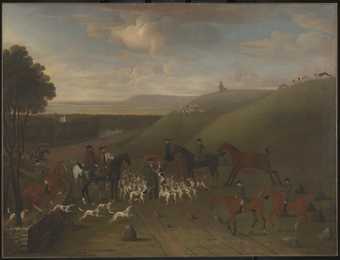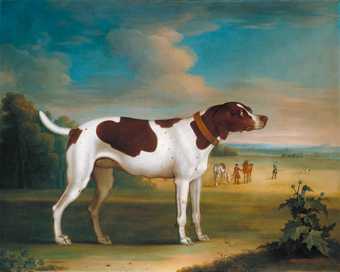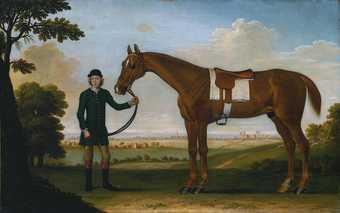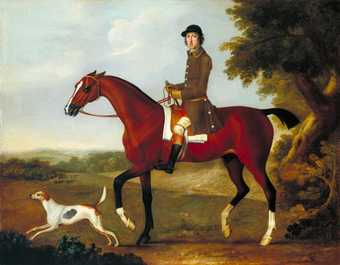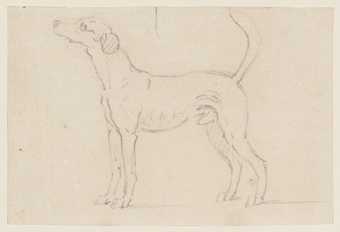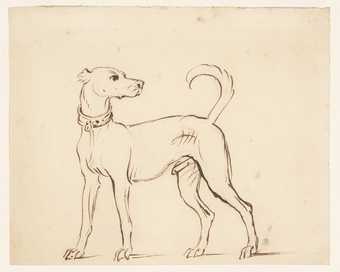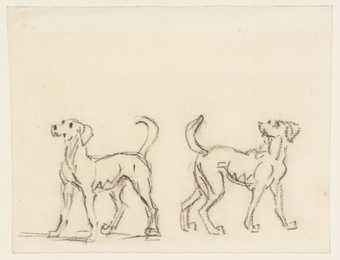Artist biography
The early sporting artist James Seymour was born in London, the son of James Seymour Sr, a wealthy banker, goldsmith, diamond merchant and amateur artist who supplied the plate for racing trophies. The elder Seymour traded at the sign of the Flower-de-Luce in Mitre Court, Fleet Street, and was a member, with John Wootton, of the Virtuosi Club of St Luke, a gentlemen's club for artists and art lovers. Through his father, the young Seymour was introduced to the leading artists of the day. Although he had no formal art training, he learnt to draw by studying pictures and prints in his father's collection. His drawings of horses heads after Tempesta and Van Dyck are in British Museum. The contemporary diarist of the art world George Vertue set out Seymour's career as follows:
Jimmy Seymor ... from his infancy had a genius to drawing of Horses ( this he pursued with great Spirit. set out with all sorts ... The darling of his Father run thro some thousands - livd gay high and loosely - horse raceing gameing women &c. country houses. never studied enough to colour or paint well. but his necessityes - obliged him. to work or starve. thus his time passd. the latter part of his life in baseness and want of all necessaries. and dyed in Town. in the lowest circumstances & in debt - Southwark June - 1752. aged about or under 50.Seymour seems also to have bankrupted his father. Passionate about racing, he is believed to have owned racehorses himself. His earliest signed and dated racehorse painting is from 1721, from which time his output was prolific, indicating that he must have established a reputation professionally. Some of his racing and hunting scenes were engraved in the 1740s and 1750s. He counted among his patrons Sir William Jolliffe, MP, and the 6th Duke of Somerset, who commissioned him to decorate a room at Petworth with portraits of racehorses. The room decoration was never completed due to a quarrel between the artist and his patron. One of the first true sporting artists in Britain, he had no other subject matter, unlike John Wootton and George Stubbs. Seymour's obituary referred to him as 'particularly eminent in horse-painting' (Gentleman's Magazine, vol.22, London 1752, p.336).
('Vertue Note Books III', Walpole Society, vol.22, 1934, p.86)
Further reading:
Walter Shaw Sparrow, British Sporting Artists from Barlow to Herring, London and New York 1922
'Vertue Note Books III', Walpole Society, vol.22, Oxford 1934, p.86
Stella A. Walker,
Sporting Art: England 1700-1900, London pp.59-61
Terry Riggs
March 1998
Wikipedia entry
James Seymour (1702–1752) was an English painter, widely recognized for his equestrian art.
Seymour was born in London. His father was an amateur artist and art dealer, whose other business dealings (as a banker, goldsmith, and diamond merchant) afforded young Seymour the leisure time to study art on his own, either his father's or the art at the Virtuosi Club of St. Luke - a gentleman's club his father belonged to, specializing in art. In a short time the boy was a self-taught artist, familiar with many of the prominent artists of the period.
Seymour's love of art was matched only by his love of horses. He began spending time at racetracks early on, and before long found himself absorbed in the sport - drawing, painting, owning, breeding, and racing horses. His art proved popular among the prominent sporting families of the day, eventually garnering Seymour patrons in Sir William Jolliffe and Charles Seymour, 6th Duke of Somerset. Jolliffe's love for horses and art proved great, and his will would later establish an equestrian statue in Hampshire. In time, Seymour's work and fame had spread throughout Europe and America.
Though ultimately his love for horseracing led to his financial ruin, Seymour still ranks among the most important early sporting artists, together with John Wootton and Peter Tillemans being considered one of the three founders of the sporting school.
This biography is from Wikipedia under an Attribution-ShareAlike Creative Commons License. Spotted a problem? Let us know.
Read full Wikipedia entry

